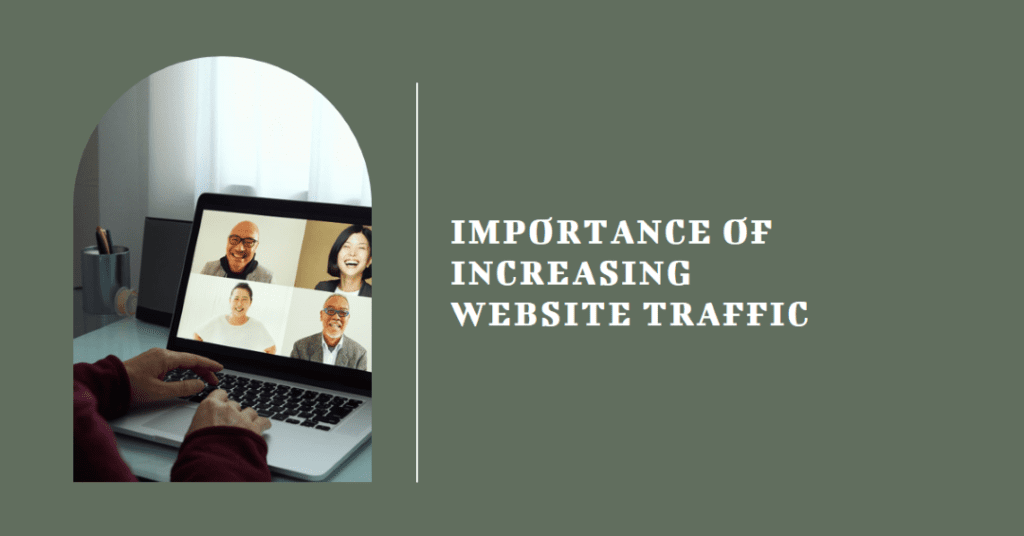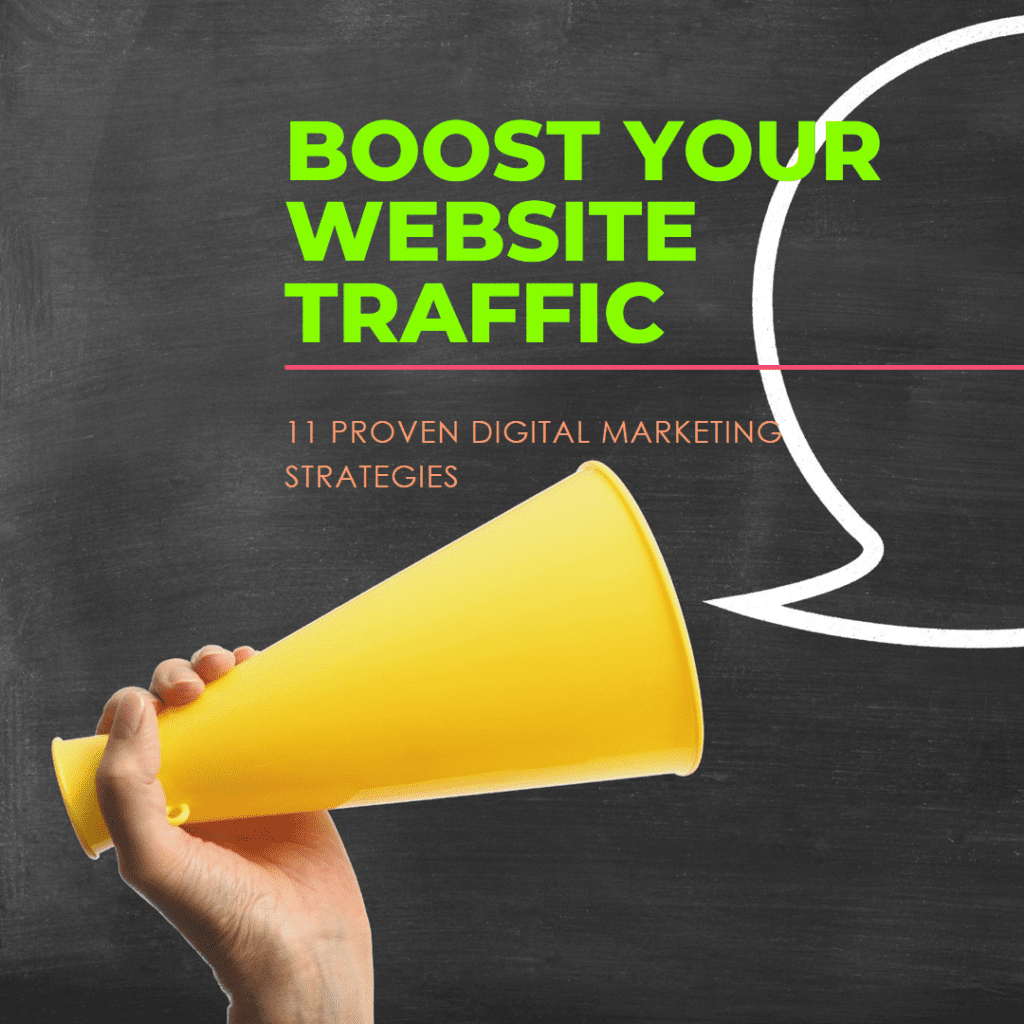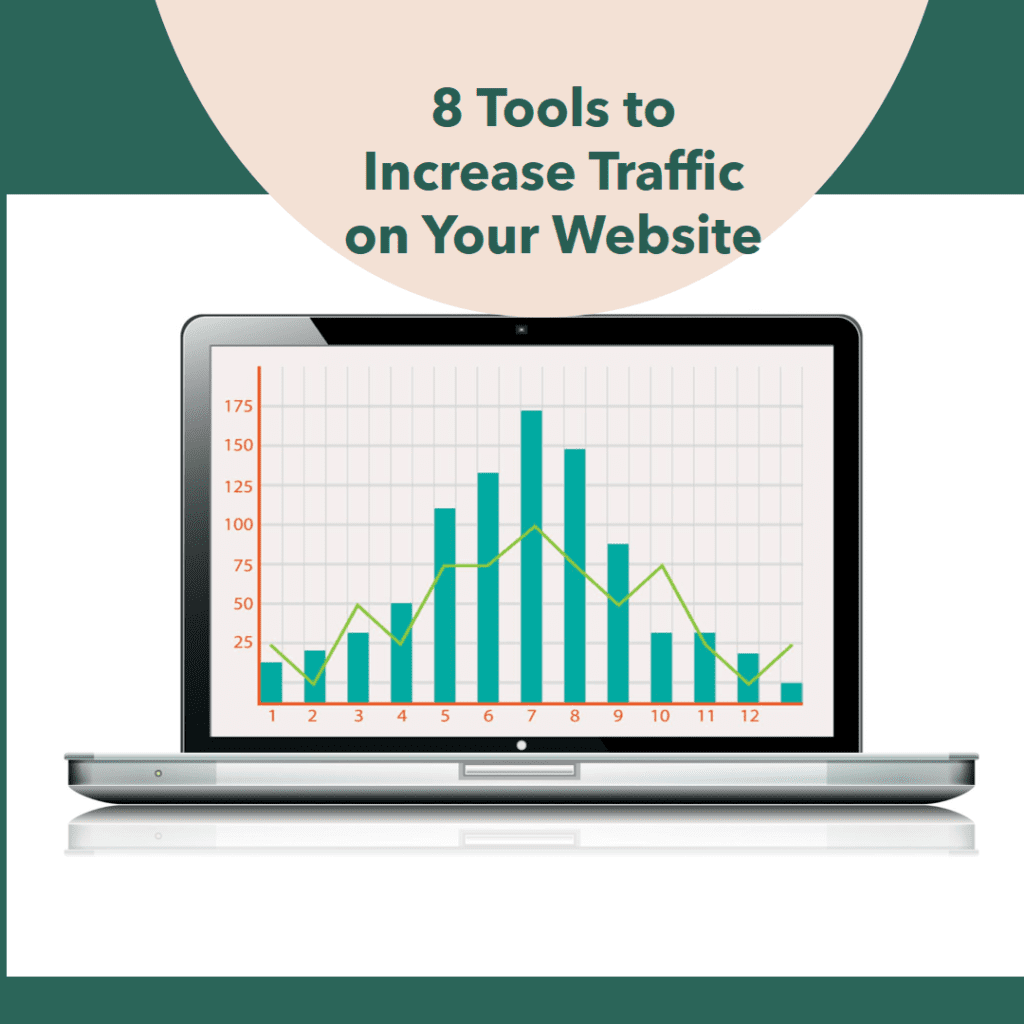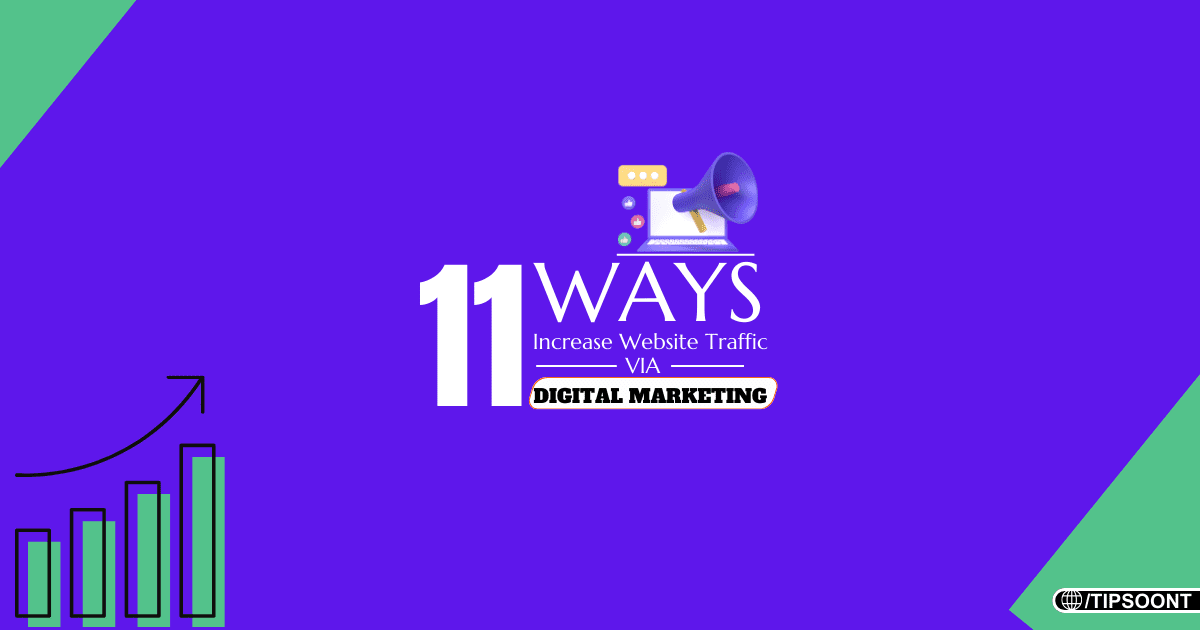In today’s world, creating a website is one of the most essential steps toward small business success. The foundation allows you to build an online presence and grow your business. Here we go to explore that how to increase website traffic via Digital Marketing.
After all, you can learn a lot about the people who visit your website and turn them into advocates, partners, or clients with suitable tools. If any of these things happen, it’s a win. Now, how do you get visitors to your website?
Digital marketing and tools can increase your website’s traffic and contribute to your business’s search engine rankings and many other benefits. One crucial aspect of an effective digital marketing campaign is developing a well-thought-out website content plan.
A website content plan serves as a roadmap, outlining the structure, theme, and goals of the quality content to be created and shared on a website.

Websites Traffic is Significant, but why do we do it?
Increased website traffic can benefit your business in many ways, such as increasing revenue, raising brand awareness, generating leads, and improving search engine rankings.
To understand your website’s performance and improve it effectively, you may need to use multiple tools, depending on its size and type.
Importance of Increasing Website Traffic
Here are several reasons why website traffic is important for business via digital marketing.

1- Increased Revenue
You may boost your business’s income by increasing traffic to your website. Increasing website traffic can directly contribute to increased revenue for businesses. The more traffic you gain the more revenue you can generate.
2- More Potential Customers
With higher website traffic, you have a larger pool of potential customers or leads to engage with.
The more people visit your website, the greater the chance of converting them into paying customers. You can leverage the increased traffic to generate more sales and revenue by implementing effective marketing and sales strategies.
3- Improved Conversion Rates
Higher website traffic provides more opportunities to optimise and improve conversion rates. By analysing visitor behaviour, conducting A/B testing, and making data-driven decisions, you can refine your website’s user experience and optimise your sales funnels.
This can lead to higher conversion rates, meaning a more significant percentage of your website visitors will become customers, resulting in increased revenue.
4- Expanded Market Reach
Increasing website traffic can help you reach a wider audience, including potential customers who may have been unaware of your brand or products.
By attracting visitors from different demographics, locations, or segments, you can expand your market reach and tap into new customer segments, increasing sales and revenue.
5- Upselling and Cross-selling Opportunities
When you have more website traffic, you have more opportunities to upsell or cross-sell your products or services.
You can increase the average order value and overall revenue per customer by strategically promoting related or complementary offerings to your visitors.
6- Advertising and Sponsorship Revenue
High-traffic websites can attract advertisers or sponsors willing to pay for ad placements or sponsored content.
With increased website traffic, you can negotiate better advertising rates or attract higher-paying sponsors, generating additional revenue streams.
7- Repeat Business and Customer Loyalty
Increased website traffic can lead to repeat business and customer loyalty. You can turn first-time visitors into repeat customers by providing a positive user experience, quality products or services, and excellent customer support.
These loyal customers are more likely to make multiple purchases over time, contributing to sustained revenue growth.
8- Brand awareness
Your business can be more visible and brand-aware by driving more traffic to your website. More website traffic means more people are exposed to your brand, products, or services.
The increased visibility can help create brand awareness and recognition, making it more likely for people to remember and consider your offerings.
9- Lead generation
Driving more traffic to a website can help your business generate more leads and potential customers. Higher website traffic can lead to an increase in potential customers or leads. More visitors mean more opportunities to convert them into paying customers.
By attracting relevant traffic, you have a better chance of generating leads and increasing sales.
10- Testing and Optimization
Higher website traffic allows you to conduct A/B testing and optimise various elements of your website, such as design, content, calls-to-action, and conversion funnels.
With more data points, you can make informed decisions about what works best for your audience and continuously improve your website’s performance.
11- Better Search Engine Rankings
Search engines use website traffic as a critical factor in determining search engine rankings. Increasing traffic to your website will increase visibility in search engine results on pages and improve your search engine rankings.
Search engines consider website traffic as a ranking factor. When your website receives more traffic, search engines perceive it as more relevant and trustworthy, which can positively impact your search engine rankings. Higher rankings can lead to even more traffic, creating a growth cycle.
12- Make your Website Findable
Ensure your site thoroughly describes your offerings
and their benefits so that search engines like Google and Bing can surface them.
Also, create a descriptive SEO title for your website to allow more people to find you. An SEO title can be added as you build your website.
13- Increased Customer Loyalty
More repeat visits and customer retention can be boosted by providing valuable content and a positive user experience.
14- Increased Social Proof
Being popular and credible on your website can increase your brand’s credibility, increasing trust among potential customers.
15- Monetization Opportunities
Websites with high traffic can explore various monetization strategies.
For example, you can display advertisements, promote affiliate products, offer sponsored content, or sell your products and services. Increased traffic provides more opportunities to generate revenue from these channels.
11 Ways to Increase Website Traffic
Here are the 11 best ways to increase website traffic via digital marketing.

- Search Engine Optimization
- On page SEO
- Quality Backlinks
- Content marketing
- Keyword Optimization
- Social Media Marketing
- Paid Advertising
- Email Marketing
- Influencer Marketing
- Guest Blogging / Guest Posting
- Analysing UI/UX
1- Search Engine Optimization (SEO)
Optimising your website’s content and structure enhances search engine results pages (SERPs).
In search engine results pages (SERPs), search engine optimization (SEO) involves optimising the content and structure of your website.
Researching keywords, using meta tags, and building backlinks are the techniques involved in this process. The optimization of your website for relevant keywords and phrases can help your website rank higher in search engine results and drive more traffic.
2- On-Page SEO
On-page SEO can help your website rank higher in search engines and increase traffic.
Some on-page SEO elements include the page title, header, meta description, image alt-text, and URL (plus more). Showing up in search engines will generate more traffic for your site.
3- Quality Backlinks
It would help if you ranked high in search engines to drive traffic to your site. It would be best if you were an authority in your industry to rank higher in search engines.
Besides the topic/cluster model described above, one way to do that is by acquiring quality backlinks. If websites with high authority link to your site, that gives you more credibility.
4- Content marketing
Engaging and attracting your target audience by creating and promoting valuable content
Content marketing involves creating and promoting relevant, valuable content to attract and engage your target audience.
You can create many types of content, such as blog posts, infographics, videos, etc. It is possible to attract and retain more visitors to your website by providing valuable content that addresses the needs and interests of your target audience
If you’re wondering how to drive traffic to your website, one great way is to craft engaging, high-quality content that may answer a question or solve a specific problem. Doing so can help build your website’s authority and position your business as an industry leader.
Creating unique, engaging, and helpful content can also help your SEO efforts. The more you optimise your content and site visits you get, the higher your site will rank on search engine results pages (SERP). Plus, posting valuable, informative content can increase the likelihood of repeat visitors. This is because readers will know that your content is helpful and reliable.
When crafting content, make sure it’s easy to read and follow. For example, a website subheading will help readers find the information they are looking for quickly and easily.
5- Keyword Optimization
When you optimise your content with keywords relevant to your business, the process is known as search engine optimization (SEO). Many business relationships are formed after someone types a word or phrase into a search engine to find a website. Knowing the search terms people use to discover your website makes it easier to draw in more visitors
Specific assignments, such as a brand or product name, may be specific to you. Or, they can be attributes or benefits like “all-natural,” “free delivery,” or something else that sets you apart.
In Google Analytics, you can view what terms your website visitors have used to find you in the past and use those keywords to help you optimise your website content. It’s also good to look at the terms your competition uses on their websites, social media, or emails.
Google Search Console is another free tool to see how often your website appears in search results, which search terms drive the most visitors, and how many people click on your site in search results.
6- Social Media Marketing
We are promoting your website and driving traffic to it via social media platforms.
Using social media platforms to drive traffic to your website is known as social media marketing.
In addition to posting updates and content on your social media accounts, you can run social media ads and interact with your followers. Building a social media presence can increase your website’s visibility and traffic.
7- Paid Advertising
You can run ads leading to your website through platforms like Google AdWords and Facebook Ads. A paid ad is an advertisement that leads people to your website using platforms like Google AdWords or Facebook Ads.
This category can include ads on search engines, display networks, and social media. Driving targeted traffic to your website is possible when your ads target your target audience.
8- Email Marketing
You can send emails with links to your website to your subscribers.
Email marketing involves sending emails to your list of subscribers with links to your website.
A newsletter, promotional email, or other type of email can be included. You can keep subscribers engaged and drive traffic to your website by emailing them regularly.
9- Influencer Marketing
Promotion of your website to the followers of influencers within your industry.
Influencer marketing is partnering with influential individuals in your industry to promote your website to their followers.
Various methods can be used, including paying influencers to create content for your site, sponsoring their posts, or partnering with them on campaigns. You can drive more traffic to your website by leveraging the reach and influence of industry influencers.
10- Guest Blogging / Guest Posting
It would be best to publish articles on other websites to drive traffic back to your site.
Writing and publishing articles on other websites to drive traffic back to your own is called guest blogging. Guest posting on other blogs or publishing articles on industry-specific websites can be involved in this process.
Publishing your content on other websites can increase your website’s visibility and traffic.
11- Analysing UI/UX
We are identifying and improving user experience, navigation, and the website’s overall performance.
This project aims to analyse and improve the user experience, navigation, and overall performance of the website.
Identifying confusing or difficult-to-navigate areas of your website is possible by analysing user behaviour, website metrics, and other data. Improved user experience leads to more engagement and traffic on your site by making it easier for visitors to find what they want.
8 Tools to Increase Traffic on Your Website
To get an accurate picture of your website’s performance and to improve it effectively, you may need to use multiple tools, depending on its size and type.

- Google Analytics
- Google Search Console
- SEMrush
- Ahrefs
- Moz
- BuzzSumo
- Hotjar or CrazyEgg
- Optimizely or VWO
1- Google Analytics
This free tool tracks traffic to your website, user behaviour, and other metrics. It can assist you in identifying areas of your website that may need improvement and understand how visitors interact with it.
2- Google Search Console
Monitoring your website’s performance in Google search results and tracking essential metrics such as clicks, impressions, and click-through rates is made easy with this free tool.
3- SEMrush
SEO tool SEMrush offers keyword research, competitor analysis, and backlink analysis. Your website’s search engine ranking can be improved by identifying relevant keywords and phrases.
4- Ahrefs
Many features are included in Ahrefs, including keyword research, competitor analysis, and backlink analysis. Identifying keywords and phrases can improve your website’s search engine rankings.
5- Moz
There are several features offered by this paid tool, including keyword research, competitor analysis, and backlink analysis. Identifying keywords and phrases can improve your website’s search engine ranking.
6- BuzzSumo
You can use this tool to identify industry influencers and research popular content.
Hootsuite or Buffer: These tools can help you schedule and manage your social media posts, increasing your website’s visibility on social media and driving more traffic.
7- Hotjar or CrazyEgg
These tools can help you determine which areas of your website need improvement for increased conversion rates and user engagement.
8- Optimizely or VWO
Testing headlines, call-to-action buttons, and layouts can help you see which elements of your website contribute most to engagement and conversions.
Final Words
Increasing website traffic is essential for achieving various business objectives, including building brand awareness, generating leads, improving search engine rankings, and maximising revenue opportunities.
It is a foundational step toward achieving online success and growing your digital presence. if you want to learn WordPress I have an introduction article posted on tipsoont.com
Thanks for reading this article We are here for Your Suggestions you can write them down in the comment section or use the Contact Us page too.
You May Like
Best Web Hosting Services for Small Business
Prerequisites and Requirements of Website Step-by-Step
Till Next, Stay Connected.
- Top 20 Trusted Online Earning Sites With Skill And Without Skill in 2025 - March 1, 2025
- 50% OFF on WordPress Website Design Services: Get Your Website for Just $199 - January 4, 2025
- Top 6 Web Developer Soft Skills & Hard Skills in 2024 - December 18, 2024







